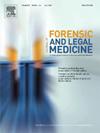主动脉夹层猝死:尸检研究(2011-2023)。
IF 1.2
4区 医学
Q3 MEDICINE, LEGAL
引用次数: 0
摘要
主动脉夹层是一种危及生命的心血管疾病,可导致猝死。本研究的目的是描述主动脉夹层猝死的流行病学和病理学特征。结果:我们对12年(2011-2023年)的尸检确诊病例进行了回顾性描述性研究。主动脉夹层占所有猝死的3.28%。死者平均年龄54.7岁(范围19 ~ 82岁),男性居多(性别比M/F = 9)。高血压在37.5%的病例中被确定,马凡氏综合征在10%中被确定,所有的个体都在40岁以下。25%的病例报告胸痛,而不适是最常见的症状(30%)。60%的病例累及升主动脉。心包填塞是最常见的死亡原因(62.5%),主要与A型夹层有关(92%)。这些事件主要发生在早晨。在48%的病例中,个人被发现死在家中。结论:主动脉夹层引起的猝死最常发生在没有事先诊断的情况下,影响相对年轻,主要是男性人群。尸检结果为改善这种致命疾病的早期发现和应急管理提供了重要数据。本文章由计算机程序翻译,如有差异,请以英文原文为准。
Sudden death due to aortic dissection: autopsy study (2011–2023)
Introduction
Aortic dissection is a life-threatening cardiovascular condition that can result in sudden death. The aim of this study was to describe the epidemiological and thanatological features of sudden deaths due to aortic dissection.
Results
We conducted a retrospective descriptive study of autopsy-confirmed cases over a 12-year period (2011–2023). Aortic dissection accounted for 3.28 % of all sudden deaths. The mean age of the deceased was 54.7 years (range: 19–82 years), with a male predominance (sex ratio M/F = 9). Hypertension was identified in 37.5 % of cases, and Marfan syndrome in 10 %, all in individuals under 40 years of age. Chest pain was reported in 25 % of cases, while discomfort was the most frequent symptom (30 %). The ascending aorta was involved in 60 % of cases. Cardiac tamponade was the most common cause of death (62.5 %), mainly related to type A dissections (92 %). The events occurred predominantly in the morning. In 48 % of cases, individuals were found deceased at home.
Conclusion
Sudden death due to aortic dissection occurs most often without prior diagnosis and affects a relatively young, predominantly male population. Autopsy findings provide crucial data to improve early detection and emergency management of this fatal condition.
求助全文
通过发布文献求助,成功后即可免费获取论文全文。
去求助
来源期刊

Journal of forensic and legal medicine
MEDICINE, LEGAL-
CiteScore
2.70
自引率
6.70%
发文量
106
审稿时长
57 days
期刊介绍:
The Journal of Forensic and Legal Medicine publishes topical articles on aspects of forensic and legal medicine. Specifically the Journal supports research that explores the medical principles of care and forensic assessment of individuals, whether adult or child, in contact with the judicial system. It is a fully peer-review hybrid journal with a broad international perspective.
The Journal accepts submissions of original research, review articles, and pertinent case studies, editorials, and commentaries in relevant areas of Forensic and Legal Medicine, Context of Practice, and Education and Training.
The Journal adheres to strict publication ethical guidelines, and actively supports a culture of inclusive and representative publication.
 求助内容:
求助内容: 应助结果提醒方式:
应助结果提醒方式:


